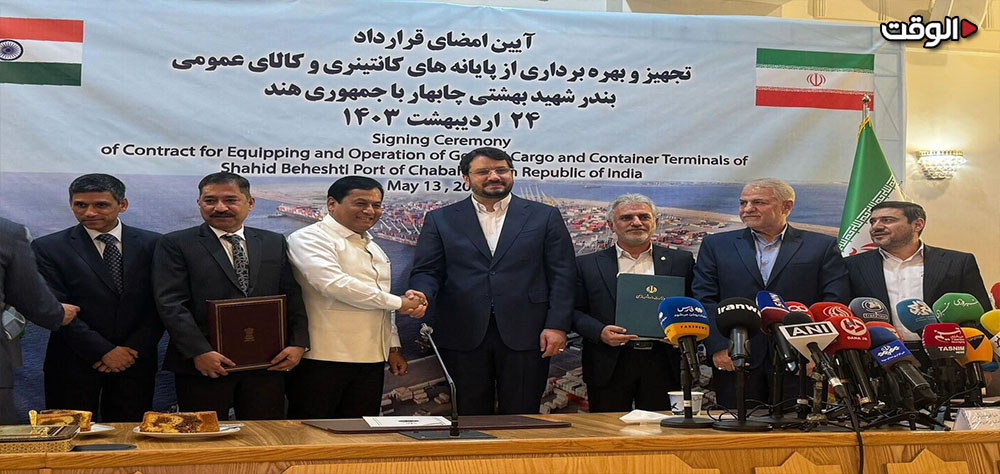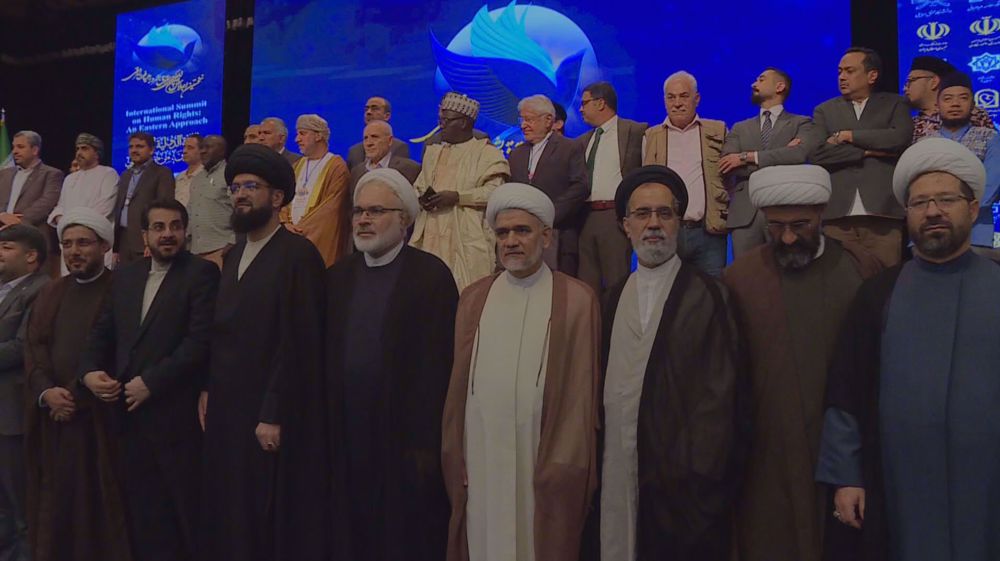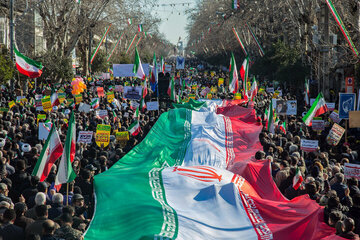Alwaght- After eight years of Indian government's procrastination and non-commitment to investment in Chabahar port, finally a long-term agreement was signed on Monday between Iran and Indian IPGL company to develop the Iranian port.
Signed in the presence of Minister of Roads and Urban Development of Iran Mehrdad Bazarpash and Indian officials, the contract includes the equipment and operation of the container terminals and general goods of Chabahar port. The value of the agreement has reached $120 million with $35 million newly added to it. Also, according to the officials of Iran's Ports and Maritime Organization, three grain suction machines with a capacity of 600 tons per hour have been added to the previous contract.
On the sidelines of the deal, Bazarpash told the journalists that Iran has regular planning for development of railroad, routes, and maritime infrastructures and the transit growth in various sectors continues.
"There is a direct line of container shipping between Iran, India and China, and in the new [Persian] year, the transportation of goods on this route has grown. A joint shipping company between Iran and India will be launched soon. Chabahar port plays a strategic role in the eastern branch of our North-South Corridor, and after the completion of the Chabahar-Zahedan railway section by the end of the year, this port will serve the country's transit development even more," he said.
Commenting on the change of the value of the contract, Bazarpash held that it was initially $85 million, but now it has increased to $120 million. "Also, we have $250 million in financing that makes the amount $370 million."
Indian ambassador to Iran Rudra Gaurav Shresth on Sunday met Iran's Deputy Minister of Roads and Urban Development and head of Iran's Ports and Maritime Organization and said that New Delhi is committed to its plans to develop Chabahar port.
Minister of Ports, Shipping and Waterways of India Sarbananda Sonwoal said in the ceremony: "Chabahar is a valuable port in terms of transit and can be used in India's connection with Afghanistan and the landlocked Commonwealth of Independent Countries."
Sonwal also met Iran's Foreign Minister Hussein Amir-Abdollahian. Iranian FM said: "Our approach to relations with India is strategic and we are ready to further expand our cooperation with India in bilateral and multilateral capacities and within the framework of BRICS and Shanghai Cooperation Organization."
Noting that Iran considers India as a reliable partner, Amir-Abdollahian stressed on Iran's approach for long-term cooperation with India. The FM described the contract for equipping and operating Shahid Beheshti Port terminals in Chabahar and boosting cooperation in the North-South Corridor as a very important opportunity to expand trade between the two countries and the region. He also highlighted the readiness of various sectors of the Iranian government to help implement this contract.
Expressing his happiness with this contract, Sonowal described that day as important and "historic" in the relations of the two countries.
"Today, the two countries of Iran and India witnessed the signing of a long-term contract to equip the Shahid Beheshti Port, and we believe that this contract can provide business development opportunities for the two countries," he said, using the official name of Chabahar port.
He added that this agreement not only strengthens ties between the "two great countries of Iran and India, but it is a solid step for India in the global supply chain and maritime sector." Sonowal called this agreement a part of India's business plans, which provides an alternative trade corridor for India, Iran, Afghanistan and Central Asian countries.
"Today, we are taking a historic action between Iran and India given the historical relations between the two countries. Before this, an agreement was signed in 2106. Now a long-term contract is signed, which is a sign of trust between the two countries. I had a very good exchange of views with the Minister of Roads and Urban Development of Iran regarding transportation and the North-South Corridor, and we will do our best to develop Chabahar port as much as possible," he said.
With the long-term deal signed between the two countries, Iran and India seem to engage in more serious partnership in this strategic port, and actually this deal opens a new chapter in their bilateral trade relations.
Influence of the deal on jump in Iranian-Indian economic ties
The security and political developments that have taken place in the past two years in the world have pushed top countries to move to regional cooperation. The emerging Eastern powers, which are preparing themselves to become superpowers in the new world order, view at the role and position of Iran as a launching pad in this direction and are trying to expand their relations with Tehran, and in the meantime, the "pivot to the East" strategy of administration of President Seyyed Ibrahim Raisi has been charming to the Asian countries.
The development of relations between Iran and India in recent years indicates the fact that New Delhi tends to increase its relations with Iran in all areas. Before the US withdrawal from the nuclear deal in May 2018, the trade between Iran and India was at an acceptable level , and this country was the second largest buyer of Iranian oil, but in recent years, under the influence of the punitive policies of Washington, these relations have suffered a lot. However, Indian media express hope past level will be restored.
Located in the extreme southeast of Iran, Chabahar port is one of the key components of India's trade connectivity initiatives and is of great importance as it provides a convenient and shorter route for trade between India, Iran, Afghanistan and Central Asia.
The purpose of India's investment in this port is to reach Afghanistan and Central Asian countries without needing its rival neighbor, Pakistan, because Indian goods can reach Central Asia through Chabahar port instead of going through Karachi port in Pakistan.
Also, India is interested in Chabahar port within its role in North-South Corridor that allows for transporting goods from its western coast to Europe. In the last decade, India eyed Iran's rail routes to enter the Eurasian markets, and for this purpose, it has invested in Chabahar port to accelerate the trade process with Iran and Central Asian states.
In 2015, India reached an agreement with Iran regarding the development of Chabahar port and the construction of a railway that connects it to Afghanistan, and in 2016, Indian Prime Minister Narendra Modi signed a $500 million investment agreement during his visit to Iran. Earlier, the Indian Foreign Minister had suggested that Chabahar port should be integrated in the North-South Corridor for the safe and unhindered access of the Central Asian countries to the sea.
"Through the port of Chabahar, India will not only reach the region of Central Asia, but there is a possibility that it will also reach Russia through the north of Iran. Today how to create communication routes is very important for diplomacy and economic relations," Indian Foreign Minister Subrahmanyam Jaishankar had earlier said.
Though the Indians, under the duress of the US sanctions, have underperformed in development of Chabahar port, the investment of New Delhi in this strategic port, in addition to helping economic prosperity in Iran, will stimulate regional trade with Central Asia.
Iran is located at the intersection of some important international transportation corridors, such as the North-South Corridor, the East-West Corridor, the Europe-Caucasus Asia Transportation Corridor program, and both countries have tried to identify Iran's transit capacities in order to complete these projects. As a result, Chabahar port is regarded as a gateway to unlock India's trade potential with European countries as it provides a shorter route to Europe.
The trade between Tehran and New Delhi has been growing in the last two years. Data recently published by the Indian Ministry of Commerce and Industry show that the country's total trade with Iran has reached $377 million in the first two months of this year. Their trade in January and February grew 5 percent compared to the same time last year. The value of trade between the two countries in the first two months of 2023 was reported $358 million.
India's exports to Iran in the first two months of this year increased by 20 percent compared to the same period last year, reaching $269 million. In the same period last year, India had exported $224 million worth of goods to Iran. However, India's imports from Iran in January and February this year dropped by 19 percent compared to the same period last year, moving down to $108 million. It imported $134 million worth of goods from Iran in January and February last year.
So, Indian investment in Chabahar port and transportation of its goods through Iranian port promise broader cooperation in the future, and this is not out of reach given the plans laid.
On the other hand, Chabahar can potentially help Iran deal with the effects of Western sanctions. India's investment in Chabahar and increasing the trade of Central Asian countries using the North-South Corridor will give Iran a special position in regional trade and prove that, despite the Western efforts to isolate Tehran, this country has been able to improve its position in global trade, and the maximum pressure campaign has practically met its failure.
Cooperation between Tehran and New Delhi in the economic, political and security areas is not new, and the two sides are considered strategic partners in many regional issues given their common interests. The membership of India and Iran in the Shanghai Cooperation Organization is effective in the development of bilateral and multilateral economic relations, and both sides can improve their relations within the framework of this bloc and be effective in the development of trade in the region. Also, two countries are members of the BRICS group, which has taken great steps to develop relations among its members, and India and Iran can play an effective role in this economic group due to their important position in the energy and economic fields in the world.
Iran's oceanic pearl: Chinese-Indian competition
The strategic location of Chabahar port, which is close to Pakistan's Gwadar port, makes it attractive to India. Chabahar port gained further importance when China started developing Gwadar port as part of its Belt and Road Initiative. Pakistan and China signed an agreement to build a deep seaport in Gwadar last year.
So, India moving close to Iran falls within the framework of competition with China and Pakistan. According to reports, on Sunday, China signed a 40-year operational deal with Pakistan. The agreement was signed to support Chinese trade overlooking the Persian Gulf and the Arabian Sea, as well as the transfer of energy through a pipeline that runs along the north and south of Pakistan.
India and Pakistan are striving to rank higher in the global economy in the decades to come, and the investment in transit corridors serves this objective, as these corridors gain further significance in world trade day by day, and any country gaining broader dominance on these routes will have a heavier weight than rivals.



























